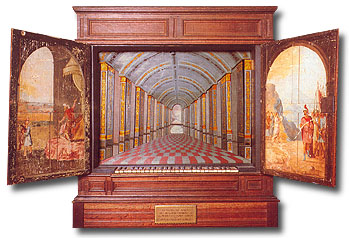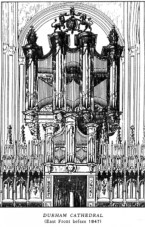
| Summarising the whole story of Durham Cathedral's organs is something of a tall order. What short-cuts can be made without compromising accuracy? Here I offer an aperitif; those seriously interested in the full record of the many known organs in and around the Cathedral precincts, with an extended appreciation and complete details of the present organ, are recommended to seek out the illustrated 64pp booklet first published by the Dean & Chapter in 1991, re-printed in 2014, so again available for purchase from the Cathedral Bookshop. For the impatient, the present organ's stoplist can be found occupying megabytes elsewhere on the Web. |
| Early reports are uncertain, but it would seem there has been an organ or organs in this building for over 700 years. Occasional references are to be found in the Priory Rolls, and a retrospective account of the life and appearance of the Priory Church before the Dissolution in 1539 describes five organs in different positions. That "ouer the quire dore" is compared with the finest in England. Two of the smaller organs survived into troubled 17th century times. |

| The main organ on the Quire screen was replaced in 1621
by Thomas Dallam, who built a number of prestigious
instruments including that for Kings College Cambridge.
Dallam case fronts survive in Brittany and England to this
day. Might the Durham organ have looked as imposing as one
of these?
At the Restoration in 1660, there was nothing to salvage, and after using temporary "little Organs...that came from London", a new organ was ordered from another of the Dallam dynasty, George, newly returned from France. It would seem this was a two manual, or double, organ of 13 stops, and cost £550, being finished for Christmas 1662. |

| George Dallam's instrument did not last or was soon
outmoded, and the Chapter contracted in 1683 with the
King's Organmaker, Bernard ("Father") Smith, for a "good,
perfect, laudable and harmonious great Organ and Chair
Organ [17 stops altogether] with a case of good, sound and
substantiall Oak wood..." for £700. In fact targets were
missed, the organ not being finished until summer 1686,
and it cost rather more, though with extra stops and more
innovation than planned. Arguably this was one of Smith's
finest organs, an impressive sight on the screen - "so
good and sound mad as anny is in the holl worrelt". The
few relics that survive - the Chaire case in the Castle,
the reconstruction of the west front, and a few scattered
ranks of pipes - are a sad reminder of what has been
lost.
In all respects a notable instrument, this lasted nearly 200 years until finally removed in 1873. En route there had been additions and alterations too numerous here to elaborate, and a disastrous transfer to the north Quire aisle in 1847. During Scott's restoration of the Quire area, 1873 to 1876, a hired 2m Gray & Davison organ sufficed. This subsequently transferred to a church in Middlesbrough now closed, and now resides, though modified, in the west gallery at St.Peter's, Redcar. |
.
The present organ
| Henry ("Father")
Willis's opus - the basis of the present
instrument - was available in part from the re-opening
ceremony on St.Luke's Day 1876, though final completion
was not achieved until March 1877. Of 55 speaking stops on
five divisions [Willis
stoplist], the new organ cost £3150 and was
thoroughly up-to-date, a first class creation of a
singularly successful Victorian organ-builder. The
functional pipe-fronts, decorated by Clayton & Bell
with oak carving by Roddis of Birmingham, under the
direction of architect Hodgson Fowler, were once
denigrated as "rolls of linoleum", but are now recognised
as splendid examples of their kind, and successful in
giving the effect "of a rich carpet...without
ostentation". Aspects of the organ's design and
construction, particularly the pneumatic action,
integrating separate elements across the Quire, and the
hydraulic blowing arrangements, tested the limits of the
technology of the time, and were to be the first parts to
falter. Gas engines soon replaced the hydraulics, but then
fumes corroded parts of the action and pipes, such that a
major overhaul was required by 1903.
Father Willis was no more, and the work - which grew in concept - was awarded to the then up and coming local firm, Harrison & Harrison, in whose loving care the instrument has since remained. Certainly a lasting reputation for excellent work was made with the reorganised and altered Durham instrument reopened in July 1905. Although no new stops were added at that time, they were planned for and eventually added in 1935 when other changes were effected, to make a four manual organ of 77 speaking stops and 20 couplers. This was again rebuilt, expanded, and rearranged, with electro-pneumatic action provided throughout, in 1970. It now comprises 98 speaking stops in 7 divisions, utilising a comfortable console of 4 manuals and Pedal, and occupies the two westernmost bays either side of the Quire, within the arcade with the exception of the Solo in the north triforium. The upkeep of such an enormous and complicated piece of equipment continues. The organ is now complete enough for most tastes, the "Father" Willis organ extensively rebuilt, enlarged and re-voiced by Harrison & Harrison, and is justly renowned, widely acclaimed as a masterpiece of Romantic organ-building, one writer enthusing "..Superb voicing, excellent acoustics and an incomparable setting all contribute to make it one of the great treasures of the English speaking world". If you don't believe it, come hear and experience the thrill for yourself. The organ is divided both sides of the quire, with the Great behind the decorated casefront and the Choir with Positive over in the first bay on the south side, whilst the Swell (in the case), Solo (in the triforium above), the Bombarde (hidden in the first bay - behind the Dean's stall!), and most of the Pedal are situated on the north side. Envy the organ stoplist on-line; soundbites do not do it justice. |
Richard Hird [www.duresme.org.uk]
More about Durham Cathedral organs:
Booklet * Present Stoplist * Recitals * The organists * Armes centenary * Father Smith gallery
Simon Fitzgerald's page (more pictures)
The Cathedral Website (including forthcoming service music, and diary of events)
| Richard Hird is co-author with James Lancelot, the Cathedral Organist, of the definitive booklet referred to above, being also locally Organs Adviser to the Diocese of Durham, and recognised inter alia for his researches into and knowledge of Durham organs past and present. |
First placed by Richard
Hird : September 1997
[www.duresme.org.uk]
.